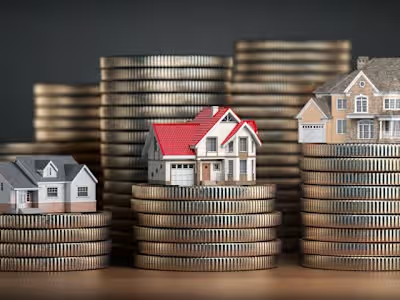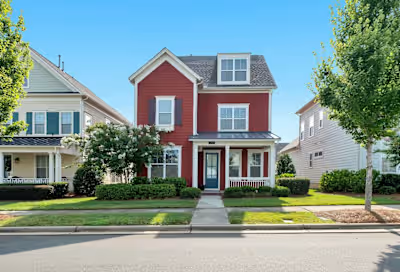Real Estate Appreciation: Comparing Natural vs. Forced
Like this project
Posted Jan 3, 2024
Learn the difference between natural and forced appreciation, what factors affect real estate appreciation, and how to calculate property appreciation.
Learn the difference between natural appreciation and forced appreciation, what factors affect real estate appreciation, and how to calculate property appreciation.
When you purchase property, whether it be as a home to live in or as an investment, the hope is that the property’s value will increase over time. This expectation of growth in property value is referred to as home appreciation. There are two forms of real estate appreciation: natural and forced.
Some real estate investors rely solely on natural appreciation, while others prefer to force appreciation through home improvements and expense management. Whether you choose to let your property value appreciate naturally or implement a few forced appreciation strategies, you’ll be well on your way to maximizing the return on your investment.
In either case, home price appreciation works in your favor as a real estate investor. As the market value of your property increases, so does the equity in your home. This translates into increased profit at the time of sale as well as increased rental income as soon as renovations are complete and the rental property is occupied.
In this article, we’ll be discussing the difference between natural appreciation and forced appreciation, what factors affect home appreciation, and how to calculate property appreciation.
What is the difference between natural appreciation and forced appreciation?
Natural appreciation is the increase in value of an investment property over time due to market forces, such as inflation or economic growth. Forced appreciation, on the other hand, is the increase in value of an investment property due to specific actions taken by the investor, such as adding a bathroom or finishing the basement in the home.
The key difference between the two is that natural appreciation is passive while forced appreciation is proactive. As a result, investors consider natural appreciation to be a safer investment than forced appreciation because natural appreciation doesn’t depend on an investor’s actions.
Instead, natural appreciation depends on the market. As long as you do your due diligence before purchasing a property, your investment should be safe and appreciate naturally. Forced appreciation is a bit riskier. Although it can be a profitable investment, investors should carefully consider the initial cost of potential home improvements, interest rates if they're borrowing money to complete renovation projects, and overall ROI before committing to a forced appreciation strategy.
How natural real estate appreciation works
Over the last decade or so, single-family homes have displayed a significant price increase of almost 67%. Rental prices have also remained strong and have consistently outpaced inflation, resulting in higher cap rates within the long-term rental market.
This is great news for investors who have implemented a buy-and-hold strategy in the right markets and consistently maintain their homes. Whether they raise their rents year after year or sell their property when the housing market peaks, responsible investors are likely to profit off of their investments.
How forced property appreciation works
Unlike natural appreciation which requires simply managing and maintaining the property, forced appreciation demands more effort and risk out of an investor. This involves completing home improvement projects, minimizing operating expenses, raising rents, or a combination of all of the above.
An investor might turn a half-bath into a full-bath, or convert a one-bedroom unit into a two-bedroom by splitting a larger room in half. These projects are completed with the intention of increasing rental income in the short-term and property value in the long run. However, a home's appreciation isn't always guaranteed.
Depending on where your property is located, the cost of labor and materials, and the state of the real estate market, forced appreciation may not be the right move for you as an investor. It’s important to carefully calculate the rate of return on your investments and understand the rental market at the time of renovation.
You could easily end up spending $20,000 on a home renovation that doesn’t warrant a significant rent increase. On the opposite end, you could spend $50,000 on a home renovation that warrants such a high rent increase that you have difficulty finding tenants willing to pay the difference. However, when done right, forced appreciation could skyrocket your property’s future value, so it’s a method worth considering.
Which type of appreciation is better?
When it comes to real estate appreciation, there’s no need to choose one when you can have both. Some of the best real estate investments create opportunities for both natural and forced appreciation. Home values are set to grow naturally, but if you can accelerate the process, even better! That's basically what forced appreciation allows you to do.
Investors focusing on apartment complexes often look for properties in upscale areas with room for improvement. When they find a property with potential, they force appreciation by renovating it. This strategy works particularly well in up-and-coming areas that have an influx of new residents.
It's worth keeping in mind that forced appreciation doesn’t always need to be immediate. You can purchase a property, rent it out for a few years and then use that rental income to reinvest into the property when you’re better acquainted with the local market and in a stronger financial position. There’s no need to rush forced appreciation. As long as you take care of your property and finances, it'll always be an option in the future.
How do you calculate the average home appreciation rate?
Calculating natural appreciation is different than forced appreciation. To calculate natural appreciation you can use the following formula:
Appreciation = (Current Value - Original Value) / Original Value * 100
If for example, you bought a home for $350,000 and it is now worth $420,000, your home has appreciated by 20%.
You can use the same equation to predict future home value by switching the numbers around.
Real estate investment strategies for natural appreciation
Although natural appreciation requires less effort than forced appreciation, investors can still implement strategies to maximize their property value. Here are some factors that affect appreciation rates:
Address property maintenance on time
A property owner relying on natural appreciation knows how important it is to stay on top of property maintenance. Nothing brings down a property’s value like delayed maintenance, especially if it affects the home's functionality or safety. Ignoring water damage for example could lead to mold and mildew creation in as little as 24 hours. Make sure you regularly perform maintenance checks and repair damage as soon as possible to avoid more expensive repairs in the future.
Keep an open line of communication with tenants
You also want to try your best to get quality tenants in your rentals. Although it can be tempting to rush through the application process simply to fill your vacancies, it’s important to properly vet your tenants before signing a lease. Look for tenants that are clean, responsible, and communicative.
It’s important to have tenants who are willing to take care of the rental while they live there and mature enough to let you know if any damage has taken place. Many times, owners don’t realize there has been significant property damage until after the tenant leaves the property. By then, it may be too late to remedy property damage, or at the very least, expensive.
Stay informed on the local real estate market
Real estate investors should also keep an eye on the neighborhood. Although property values don’t change overnight, they are heavily influenced by the area in which they are located. If you or your real estate agent notice crime rates are up and businesses are starting to shut down, this may be an indication that the neighborhood is not doing as well as it once was. Depending on your goals as an investor, it may be time to sell or hold off on a new purchase altogether.
Real estate appreciation: Maximizing returns through strategic approaches
There are two primary types of real estate appreciation: natural appreciation and forced appreciation. Natural appreciation refers to the increase in property value over time due to market forces, such as inflation and economic growth. Forced appreciation, on the other hand, is the result of specific actions taken by the investor to improve the property's value, such as renovations or increasing rental income. Each approach comes with its own set of risks and rewards, making it important for investors to carefully consider their goals and circumstances.
Natural appreciation
Natural appreciation is considered a safer investment option as it depends on market conditions rather than the investor's actions. By conducting thorough due diligence before purchasing a property and maintaining it diligently, investors can ensure that their investment appreciates over time. Additionally, maintaining open communication with tenants and staying aware of the local real estate market can help investors safeguard their investments and make well-informed decisions.
Forced appreciation
Forced appreciation, while riskier and time-consuming, can lead to significant rewards when executed correctly. Investors who take on this strategy need to be prepared for the additional effort and costs involved in renovating the property and increasing its value. It requires a deep understanding of the rental market and careful calculation of potential returns to avoid overextending finances without generating significant returns.
How to combine natural and forced appreciation strategies
The best approach to real estate appreciation is not an either/or decision between natural and forced appreciation. Instead, savvy investors often combine both strategies to maximize their returns. By identifying properties with potential for improvement and implementing forced appreciation through renovations and other enhancements, investors can accelerate the appreciation process. This approach is particularly successful in up-and-coming areas experiencing growth and attracting new residents.
It's worth noting that forced appreciation doesn't always require immediate action. Investors can purchase a property and rent it out for a period, using the rental income to reinvest in the property later when they are better acquainted with the local market and in a stronger financial position. This patient and strategic approach can lead to substantial appreciation over time.
Calculating the average home appreciation rate is essential for assessing investment performance. By using the formula provided in the article, investors can track and project property appreciation based on market trends and property value changes.
Final thoughts on property appreciation
Regardless of the chosen approach, responsible property management remains crucial for successful real estate investment. Timely property maintenance, thoughtful tenant selection, and staying informed about the neighborhood's real estate market are important factors in ensuring long-term appreciation and overall success.
In conclusion, the world of real estate appreciation offers numerous opportunities for investors. Understanding the differences between natural and forced appreciation empowers investors to make informed decisions that align with their goals and risk tolerance. By combining market-driven appreciation with proactive strategies, investors can unlock the full potential of their real estate investments and achieve lasting financial success in the dynamic world of real estate.
Vivian is a freelance real estate writer based in Brooklyn, NYC providing SEO blogging services to real estate companies. Her work focuses on educating first-time real estate investors on investment strategy and explaining proptech tools to new customers.







